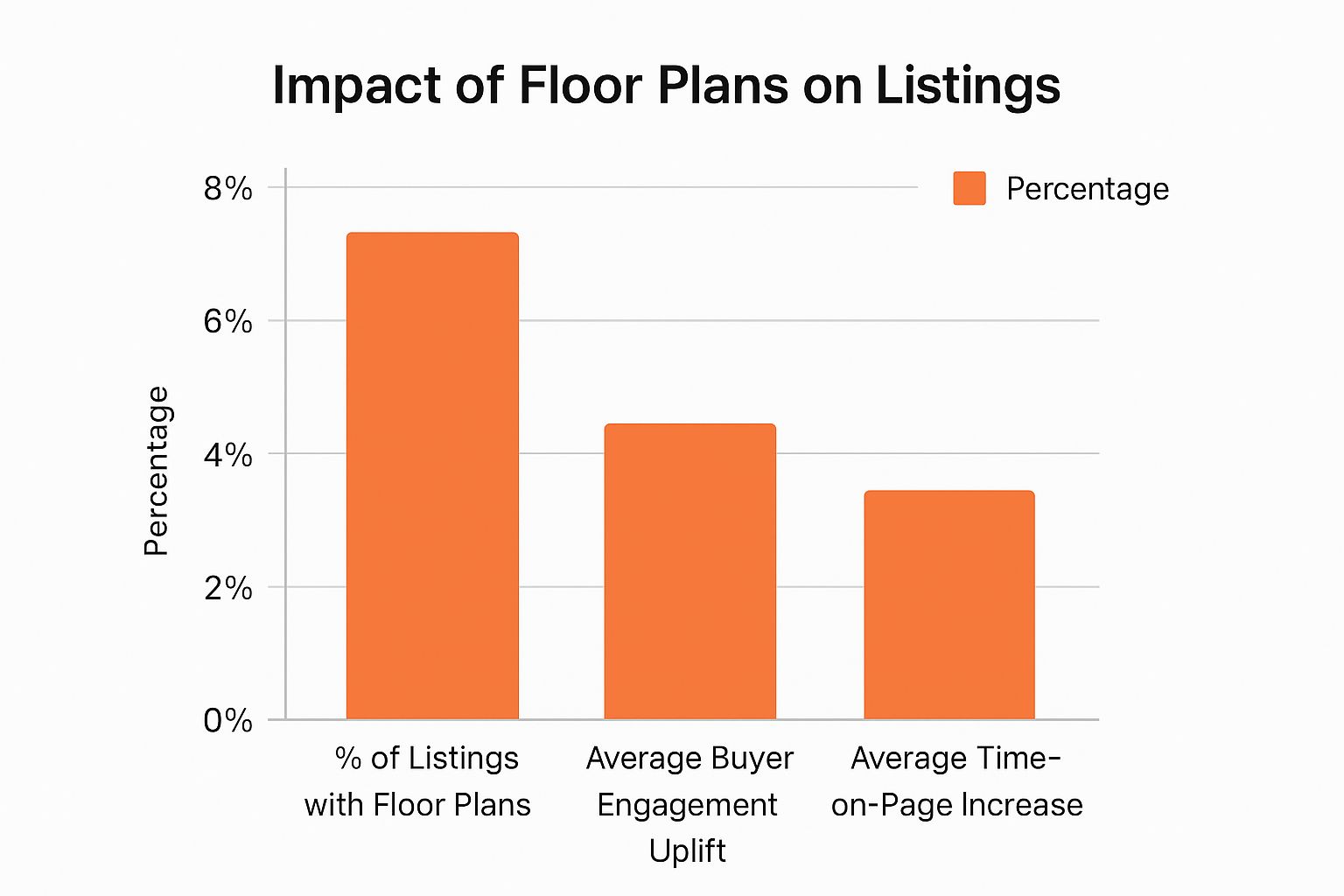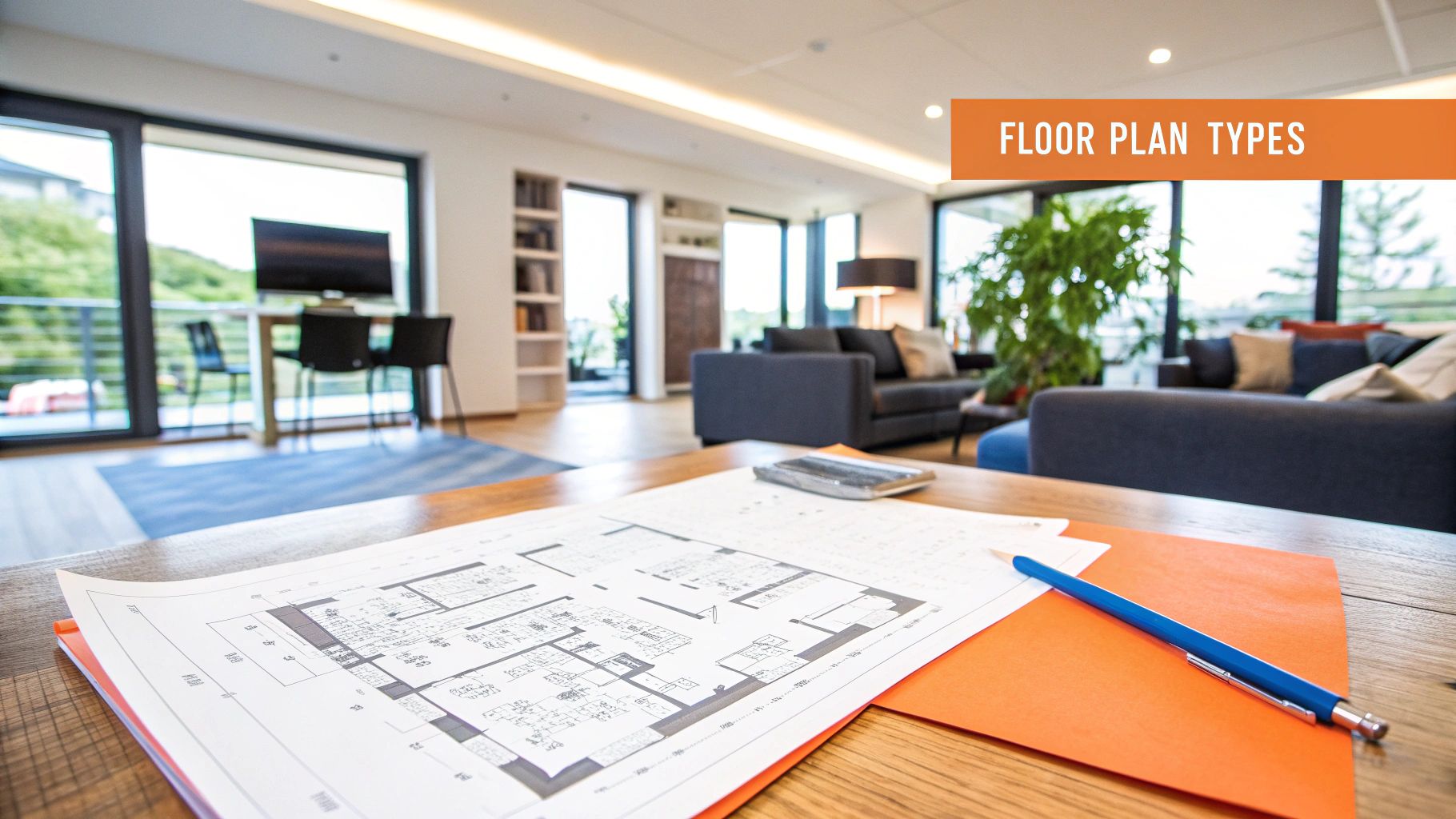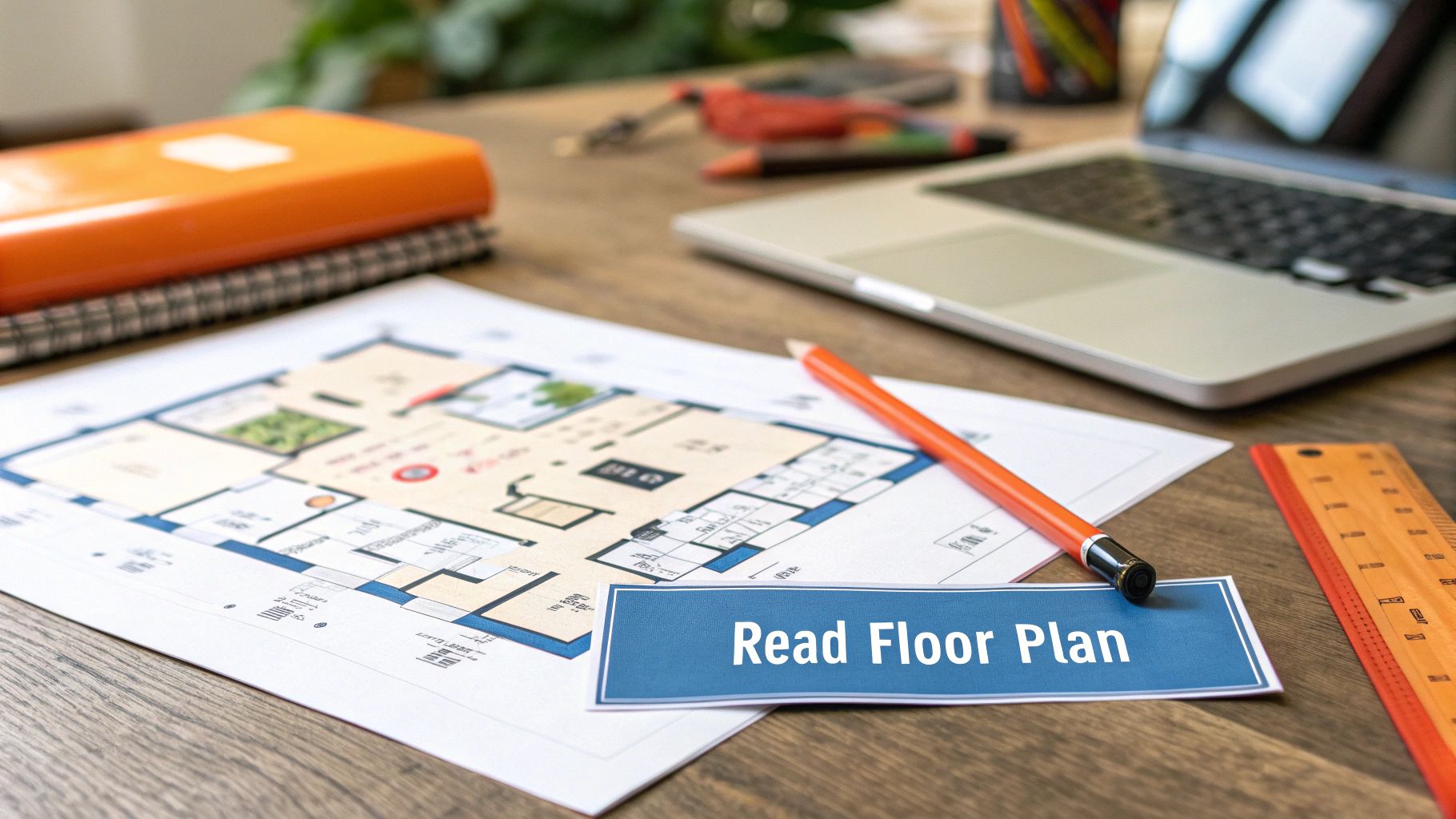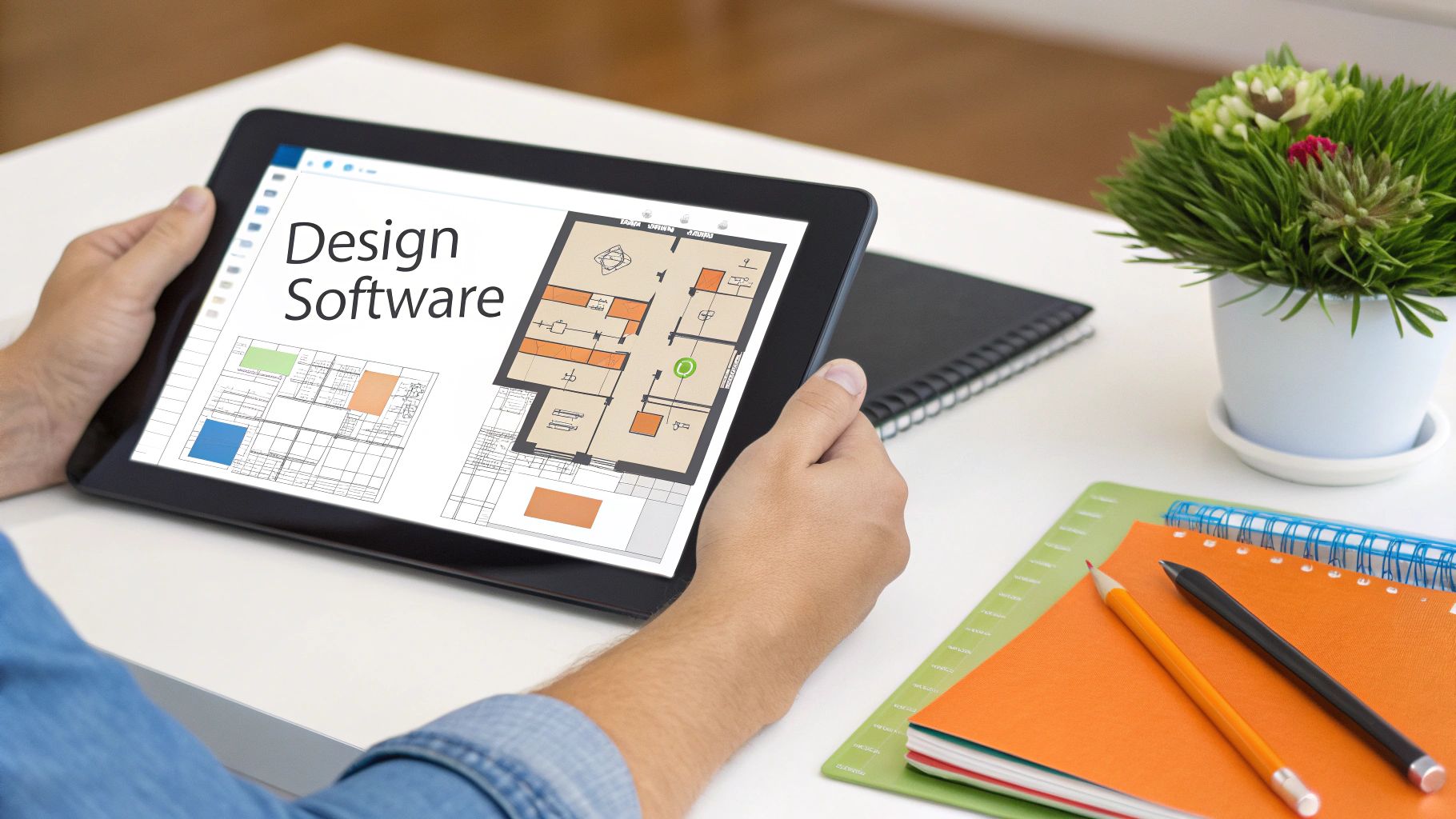Real Estate Floor Plans: Boost Your Property Listings
Discover the power of real estate floor plans to attract buyers, showcase your property, and sell faster. Learn how to create effective floor plans today.
In a crowded market, a real estate floor plan isn’t just a nice extra—it’s one of the most powerful tools you have. It works wonders by building instant trust with potential buyers, saving precious time for everyone involved, and making your listing stand out from the competition.
Why Floor Plans Are No Longer Optional
Think about it from a buyer’s perspective. They’re scrolling through dozens, maybe hundreds, of listings. After a while, all those beautiful photos of different kitchens and living rooms start to blur together. A floor plan cuts right through that noise. It’s more than a technical drawing; it’s a blueprint for a potential new life, showing how the home flows and how someone could actually live in it.
A floor plan is like the property’s resume. The gorgeous photos are the attention-grabbing cover letter, but the floor plan provides the real substance. It answers the practical, make-or-break questions before a buyer ever needs to schedule a visit:
- Will our king-size bed actually fit in the main bedroom?
- Is the kitchen really open to the living room for entertaining?
- Can I have a home office far enough away from the kids’ rooms to get any work done?
The Hard Numbers: Data on Why Floor Plans Work
This isn’t just a gut feeling; the data is crystal clear. Adding a floor plan isn’t a minor tweak. It’s a strategic move that directly impacts how buyers interact with your listing.
The statistics are compelling. A massive 81% of homebuyers say a floor plan is essential to their property search. Even more telling, 80% of visitors on real estate websites click on the floor plan before they even scroll through the photo gallery. It’s often the first thing they look for.
The immediate impact is significant. Listings that include a floor plan can see their click-through rates from potential buyers increase by as much as 52%. That’s a huge boost in getting serious eyeballs on your property from the very start.
Here’s a quick look at the direct benefits.
The Immediate Impact of Including a Floor Plan
| Metric | Impact |
|---|---|
| Buyer Preference | 81% of homebuyers find them essential. |
| Website Engagement | 80% of visitors view the floor plan first. |
| Listing Clicks | Click-through rates can increase by up to 52%. |
These numbers show just how much a simple floor plan can do to attract and engage the right kind of buyers.
The infographic below offers a great visual breakdown of how a floor plan boosts engagement and the time a buyer spends looking at your listing.

Image
As you can see, that simple addition makes a world of difference in holding a buyer’s attention.
Building Trust and Attracting Serious Buyers
When you provide a floor plan, you’re showing you have nothing to hide. That transparency builds immediate trust and empowers buyers to see if the home is a genuine fit for their needs, all on their own time. This saves you—and them—from countless hours spent on showings for properties that were never going to work.
A floor plan turns a passive browser into an engaged planner. It invites them to mentally arrange their furniture and imagine their daily routines, creating an emotional connection long before they step foot inside.
This early engagement means that the people who do book a showing are already highly qualified and genuinely interested. For more insights on building listings that convert, you can explore more of our real estate strategies and tips. Ultimately, this one simple asset gives you a huge advantage, helping you attract better leads and close deals faster.
What Makes a Floor Plan Effective

Image
We’ve all seen them—those blurry, hand-drawn sketches that do more to confuse buyers than to help. Let’s be honest, not all real estate floor plans are created equal. A great floor plan is a blueprint for living. It tells a visual story that helps buyers instantly imagine their life unfolding within those walls.
Think of it like this: property photos show the home’s style and finishes, but the floor plan reveals its soul. It shows the flow, the function, and the fundamental logic of the space. It’s the difference between admiring a car’s shiny exterior and getting to look under the hood to see how it really works.
To be a truly powerful sales tool, a floor plan must do more than just outline the walls. It needs to communicate essential information clearly and intuitively.
Clarity and Accuracy Are Non-Negotiable
The absolute bedrock of a good floor plan is clarity. A potential buyer should be able to understand the layout at a glance, without squinting to decipher labels or guessing which room is which. This starts with getting the basics right.
The most effective floor plans always include:
- Distinct Room Labels: Every single space, from the primary bedroom down to the hall closet, needs a clear label. Stick to full words, not confusing abbreviations.
- Precise Dimensions: This is huge. Including measurements (like “Living Room: 12’ x 14’”) is critical. It allows buyers to see if their king-sized bed or sectional sofa will fit, removing a major point of hesitation.
- Window and Door Placement: Showing where windows and doors are located helps buyers understand natural light and how they’ll move from room to room.
- Indication of Flow: The layout itself should guide the eye, showing how spaces connect and how a person would naturally walk through the home.
An effective floor plan removes guesswork. It answers a buyer’s practical questions before they even think to ask them, building confidence and making them feel more in control of their decision-making process.
When buyers can easily see these details, they can start picturing themselves in the home. You can learn more about creating layouts that do just that with the Pedra floor plan generator.
Furnished vs. Unfurnished: The Story Each Tells
Once you have the basic structure down, you face a choice: do you go with a simple 2D black-and-white plan or a more immersive 3D furnished one? Each tells a different part of the property’s story.
A 2D unfurnished plan is all about the facts. It’s the clean, architectural view that shows dimensions, structure, and flow without any distractions. This is perfect for the practical buyer who wants to pull out a measuring tape and plan their furniture placement with precision.
On the other hand, a 3D furnished floor plan is all about inspiration. By adding furniture and depth, you help buyers overcome the challenge of picturing an empty room. They can immediately see how a living room could be set up for movie nights or how that extra bedroom could become a perfect home office. This is especially helpful for properties with unconventional layouts.
Highlighting the functionality of key areas is also crucial. For example, if the kitchen boasts an efficient, modern design, showing it as one of the top kitchen layouts can make the entire home feel more appealing.
Ultimately, the best strategy is often to offer both. Give buyers the hard data they need and the visual inspiration they crave.
How Floor Plans Influence Buyer Psychology
https://www.youtube.com/embed/-mLHiaE6wCM
A real estate floor plan does so much more than show walls and room sizes. It speaks directly to a buyer’s imagination. Think about it: in a crowded market, buyers are scrolling through endless photo galleries. A clean, simple floor plan cuts right through that visual clutter.
It’s the tool that helps a buyer mentally connect the dots, turning a series of pictures into a space they can actually imagine living in. This is where the real connection begins. They aren’t just looking at a house anymore; they’re subconsciously trying it on for size.
From Viewer to Homeowner in Their Mind
The most powerful thing a floor plan does is spark mental ownership. The moment a buyer sees the layout, they instinctively start placing their own furniture, figuring out their morning coffee routine, and picturing where the Christmas tree would go.
This little act of “mental moving in” is a huge leap in the buying process. It’s the switch that flips a passive browser into an engaged, serious prospect. Once they’ve started building an emotional attachment to the space, they’re far more likely to book a showing.
Building Confidence and Reducing Uncertainty
Buying a home is a massive financial decision, and it’s naturally filled with anxiety. A good floor plan is one of the best ways to ease that stress. It gives buyers cold, hard facts that photos simply can’t.
It instantly answers those nagging questions that can make a buyer hesitate:
- Space and Flow: Does the layout actually work? Is the kitchen close enough to the dining room?
- Privacy: Are the bedrooms tucked away from the noisy living areas?
- Usability: Is there enough storage? Will my king-sized bed even fit in the master?
By answering these questions upfront, you build a foundation of trust. The buyer feels more confident and in control because they have real data to back up their gut feeling about the property. It shows you’re being transparent and respecting their need for information.
This is more important than ever. The U.S. residential real estate market was valued at an incredible $106.7 trillion in 2024, a jump of nearly 49% since just 2019. With home prices high and inventory low, buyers are under immense pressure to decide quickly. In this climate, a detailed floor plan isn’t just a nice-to-have; it’s essential for helping them make smart, fast decisions. You can dive deeper into these market conditions with these recent real estate trends and statistics on Fixr.com.
Attracting More Committed Buyers
All these psychological benefits directly translate into a smoother sales process for you. When buyers can see the layout and qualify the property for themselves before they even call, the leads you get are so much better.
A floor plan acts as a filter. It weeds out buyers for whom the layout would never work, ensuring that the people who do book a viewing are already seriously considering making an offer.
What does this mean for you? Fewer wasted appointments and more productive conversations with people who are genuinely interested. You’re no longer just showing a house; you’re presenting a clear solution to a buyer’s needs. This simple document helps attract serious buyers who are ready to make a move because they can already see themselves calling your listing “home.”
How to Create Real Estate Floor Plans Today
Not long ago, getting a professional floor plan meant one of two things: hiring a pricey architect or fighting with complicated design software. Thankfully, those days are over. Technology has completely changed the game, giving real estate agents powerful and easy-to-use tools that fit any budget or skill level.
There are a few ways to get the job done. You can still go the traditional route and hire a professional drafter, which guarantees precision but can be slow and expensive. You could also try your hand at DIY software or a mobile app. But the most exciting development is the rise of AI-powered services that offer the perfect blend of speed, quality, and affordability.
Let’s dive into the modern options that are helping agents create fantastic floor plans without the headache.
Quick and Easy Mobile Apps
When you’re out in the field and need a floor plan fast, your smartphone is all you need. Several mobile apps let you generate a basic layout in just a few minutes, right on the spot.
These apps cleverly use your phone’s camera and sensors. You just open the app, point your camera, and walk around the room. The app scans the space, measures the dimensions, and pieces together a simple layout. It’s perfect for getting a quick sense of the property’s flow or for giving a client an initial look. While it might not be polished enough for a final marketing package, it’s an incredible tool for creating a rough draft that you can refine later.
The Power of AI Floor Plan Generation
This is where things get really interesting. AI-powered services have fundamentally shifted how we create floor plans, striking a perfect balance between professional quality and user-friendliness.
The process couldn’t be simpler. You don’t need any design skills at all. You just provide a basic sketch or file, and the AI handles the rest. Seriously, you can start with almost anything:
- A quick sketch you drew on a napkin.
- An old, faded blueprint from the town records.
- A simple video you filmed while walking through the home.
You upload your file, and the AI gets to work. It analyzes the visual information, identifies the walls, doors, and windows, and automatically generates a clean, professional, and properly scaled floor plan.
This technology has made high-quality marketing assets accessible to everyone. What used to take days of work and a big budget can now be done in a few hours for a fraction of the cost. It’s a true game-changer that levels the playing field for agents.
Tools like Pedra are leading this charge, turning something as simple as a sketch into a polished, client-ready floor plan with just a few clicks.
Here, you can see just how straightforward the process is on Pedra’s platform. An agent can simply upload a file and let the AI do all the heavy lifting.

Image
The beauty of this is its simplicity. It removes all the technical hurdles, letting you focus on what you do best: selling homes.
From 2D Layouts to Interactive Experiences
But why stop at a flat, 2D drawing? The same technology that creates these plans can also turn them into fully furnished 3D models. This gives buyers a much richer, more immersive feel for the space, helping them truly picture themselves living there.
And for those who want to offer a truly premium experience, you can go even further. Advanced technologies now enable the creation of interactive architectural visualizations using pixel streaming, allowing a potential buyer to “walk through” a stunningly realistic digital version of the property right from their own computer. It’s the next best thing to being there in person.
By embracing these modern tools, any agent can consistently produce high-quality floor plans that grab attention, build buyer confidence, and ultimately, get properties sold faster.
Don’t just think of a floor plan as a one-and-done upload. A great floor plan is a powerful marketing tool you can use again and again across all your channels. The best agents I know treat it as a foundational piece of content, not just a static image for the MLS.
When you see a floor plan as more than just a blueprint, you can start building conversations around it. It’s about creating a ripple effect that keeps potential buyers interested long after their first glance. To really squeeze every drop of value out of your floor plans, you need an effective content repurposing strategy that puts them to work everywhere.
The idea is to stop just showing information and start creating experiences.
Sparking Conversations on Social Media
Social media is the perfect place to get creative with your floor plans. Instead of just posting the image and calling it a day, you can turn it into something that gets people talking and clicking.
Here are a few simple ideas to try:
- Run a “Which Layout Do You Prefer?” poll. Show the same floor plan furnished two different ways—maybe one as a home office and the other as a guest room. Ask your followers to vote. It’s an easy way to boost engagement and get a feel for what buyers in your area are actually looking for.
- Start a “Guess the Square Footage” contest. Post an unfurnished floor plan and let people guess the total area. It’s a fun, low-stakes game that gets people to interact with your posts.
- Spotlight a unique feature. Zoom in on one part of the floor plan, like a smart storage nook or a fantastic primary suite, and create a post explaining why it’s so great.
This kind of content does more than just fill your feed; it shows you’re an expert who genuinely understands what makes a house a home.
Supercharging Your Email Marketing
Your email list is gold for nurturing leads, and floor plans can make your newsletters so much more compelling. Use them to give your subscribers a VIP preview of new properties before they ever hit the market.
Pro Tip: Including a floor plan in a “Coming Soon” email gives it an exclusive, urgent feel. You’re giving your most dedicated followers the first crack at a new property, which often sparks early interest and can even lead to pre-market offers.
Think about it: an email with the subject line, “Your First Look: The Perfect Family Layout in [Neighborhood].” Inside, your subscribers find the floor plan and a few key details, with an invitation to reply for a private tour. It’s a fantastic way to build value and make your followers feel special.
A Must-Have for Multifamily Leasing
For apartment buildings and large rental properties, floor plans are absolutely essential. In multifamily, having a library of accurate layouts isn’t just a nice marketing perk—it’s a core part of day-to-day operations. Leasing agents depend on them to show different units to potential renters, many of whom might be searching from out of town.
In a crowded rental market, being able to instantly show a prospect the difference between Apartment 5B and Apartment 12C can make or break a deal. With new construction starts projected to be 74% below their 2021 peak, the market is tight and every little advantage helps. Clear, accurate floor plans help leasing teams work smarter, allowing renters to make confident decisions without needing to tour every single available unit. Ultimately, that means filling vacancies faster.
When you use it right, a single floor plan can be one of your hardest-working marketing assets, paying dividends long after a property is sold or rented.
Best Practices for Presenting Your Floor Plan

Image
You’ve got a beautiful, accurate floor plan. That’s a huge step. But how you present it can make or break its impact on a buyer. A fantastic plan gets completely lost if it’s poorly placed or hard to read. Following a few simple practices ensures your real estate floor plans do their job—attracting buyers and selling the property.
Think of your floor plan as a critical piece of your visual storytelling. You wouldn’t use blurry photos, right? The same standard applies here. Your floor plan needs to be crisp, clean, and professional so a potential buyer can understand the layout in a single glance.
Keep It Clean and Uncluttered
The number one rule? Readability. A cluttered, messy layout will only confuse and frustrate buyers, encouraging them to click away. When it comes to floor plans, simplicity is your best friend.
Stick to a clean design with clear, legible text for all the room labels and dimensions. You’ll want to avoid packing the drawing with too many details or using decorative fonts that are tough to decipher. The information itself is the star of the show.
A great floor plan delivers critical information with quiet confidence. It should feel less like a dense architectural document and more like a helpful, easy-to-read map of a potential new home.
By keeping the visuals simple, you make sure the crucial details—like room flow, size, and layout—are what stand out.
Provide Context and Orientation
A floor plan just floating in space doesn’t tell the whole story. Two small additions can make a world of difference in helping buyers truly connect with the property.
- Add a Compass: It’s a small detail with a big impact. Including a simple compass rose showing which way is north helps buyers understand the home’s orientation. This is vital for figuring out things like where the morning light will hit or if the patio gets evening sun.
- Show Outdoor Spaces: Don’t forget the balconies, decks, patios, and yards! Showing how the indoor and outdoor living areas connect is a huge selling point. It helps buyers visualize the complete lifestyle the property offers.
These details provide a much more complete picture, often answering questions buyers didn’t even know they had yet.
Strategic Placement in Your Listing
Where you put the floor plan in your online listing matters. A lot. Don’t make the mistake of burying it at the end of a 40-photo gallery. By that point, you might have already lost their attention.
The best move is to place your floor plan right after the main “hero” shots of the property. For example, show the stunning exterior, the beautiful kitchen, the inviting living room, and then—boom—the floor plan. This timing is perfect. It allows a buyer to connect the gorgeous photos they just saw to the home’s actual layout, building a mental model of the space while their interest is at its peak.
This visual one-two punch is incredibly powerful. For more ideas on making your visuals shine, check out our guide on essential real estate photography tips. When you present your floor plan thoughtfully, you turn a simple drawing into one of your most effective sales tools.
Your Top Floor Plan Questions, Answered
Floor plans are a game-changer for listings, but it’s natural to have questions before diving in. I’ve heard them all from agents and sellers over the years. Let’s walk through some of the most common ones so you can feel confident putting them to work for you.
Are Floor Plans Really Worth the Cost?
Without a doubt. While you do have to spend a little to get a quality floor plan, the return on that investment is massive. Think about this: listings that include a floor plan can see their click-through rates skyrocket by as much as 52%. That means you’re getting more eyeballs from truly interested buyers, right from the get-go.
It’s less of an expense and more of a smart marketing investment. It weeds out buyers who aren’t a good fit and brings in the ones who are, which often means a faster, smoother sale.
A great floor plan acts as a pre-qualifier. It gives buyers the spatial context they need to know if a house is a real possibility for them. When they finally book a showing, they aren’t just curious—they’re already picturing their life there and are that much closer to making an offer.
Do I Bother with a Floor Plan for a Small Condo or House?
Yes, and you might argue it’s even more important for smaller spaces. For condos, townhouses, and co-ops, a floor plan is your secret weapon to showcase the home’s true potential. We all know that wide-angle photos can sometimes make a room look bigger or smaller than it really is, which can lead to disappointment. A floor plan cuts through that by providing hard, reliable dimensions.
It’s all about helping buyers see how their furniture would fit and how the space flows. A floor plan proves that a compact home can still be incredibly functional and feel just right. For a condo, it’s also the best way to clearly show its specific layout within the larger building.
What if My Floor Plan Isn’t 100% Accurate?
Honesty is always the best policy here. If you know there’s a slight difference between the floor plan and the property—maybe a wall was moved during a renovation or you’re working off an old blueprint—it’s crucial to be upfront about it.
Simply add a clear disclaimer like “For illustrative purposes only” or “All dimensions are approximate.” This small step protects you, manages expectations, and builds trust. Buyers are generally reasonable and understand that minor variations can happen. Being transparent from the start prevents any surprises down the line and keeps the deal moving smoothly.
Ready to create stunning, accurate real estate floor plans with a single click? Pedra uses AI to transform your simple sketches or videos into professional marketing assets instantly. Try Pedra today and see the difference.

Related Posts
3D Photography for Real Estate Guide
Explore our guide to 3D photography for real estate. Learn how immersive virtual tours can attract q...
Effective Copywriting for Real Estate to Sell Homes Fast
Discover expert copywriting for real estate that boosts property sales. Learn tips to craft compelli...
Top Floor Plan Creator Software of 2025 | Design with Ease
Explore the best floor plan creator software of 2025. Find intuitive tools and powerful features to ...